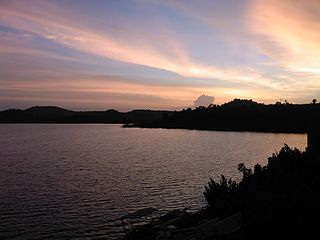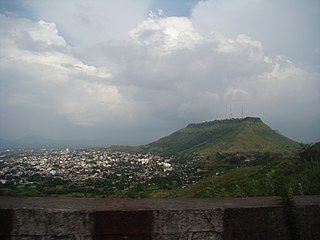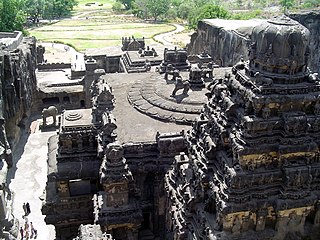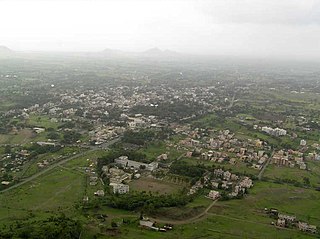Related Research Articles

Yavatmal district, [jəʋət̪maːɭ] formerly known as Yeotmal, is a district of the Indian state of Maharashtra. It is located in the region of Vidarbha, in the east-central part of the state. It is Vidarbha's third-largest district by population, after Nagpur and Amravati. Yavatmal city is the administrative headquarters of the district.

Satara is a city located in the Satara District of Maharashtra state of India, near the confluence of the river Krishna and its tributary, the Venna. The city was established in the 16th century and was the seat of the Chhatrapati of the Maratha Kingdom, Shahu I.

Alibag, also known as Alibaug, is a coastal city and a municipal council in Raigad district of Maharashtra, India. It is the headquarters of the Raigad district and is south of the city of Mumbai. Alibag is part of the Mumbai Metropolitan Region and is situated at a distance of about 96 km from Mumbai and 143 km from Pune.

Osmanabad District, officially known as Dharashiv District, is an administrative district in the Marathwada region in the Indian state of Maharashtra. The district headquarter is located at Osmanabad. The District of Osmanabad derives its name from the last ruler of Hyderabad, the 7th Nizam, Mir Osman Ali Khan, of which the region was a part till 1947. This region was earlier part of The Hyderabad State until Independence.This primarily rural district occupies an area of 7,569 km2 (2,922 sq mi) of which 241.4 km2 (93.2 sq mi) is urban and has a population of 1,657,576 of which 16.96% were urban.

Aurangabad district, officially known as Chhatrapati Sambhaji Nagar district, is one of the 36 districts of the state of Maharashtra in western India. It borders the districts of Nashik to the west, Jalgaon to the north, Jalna to the east, and Ahmednagar to the south. The city of Aurangabad houses the district's administrative headquarters. The district has an area of 10,100 km2, of which 37.55% is urban and the rest is rural. Aurangabad District is a major tourism region in Marathwada, with attractions including the Ajanta Caves and Ellora Caves.

Junnar is a city in the Pune district of the Indian state of Maharashtra. The city has history dating back to the first millennium. The nearby fort of Shivneri was the birthplace of Maratha king Shivaji, the founder of the Maratha Empire. Junnar was declared the first tourism taluka in Pune district by the government of Maharashtra on 9 January 2018.

Pune district is a district in Western Maharashtra with Administrative Headquarters in Pune city. Pune district is the most populous district in the Indian state of Maharashtra. It is one of the most industrialised districts in India.
Phaltan is a City, a Tehsil, and a Municipal Council in the Satara district in the Indian state of Maharashtra. The City is about 59 kilometres (37 mi) northeast of the city of Satara and about 110 km from Pune.
Udgir is the second largest city in Latur district and Municipal Council of the Indian state of Maharashtra. It is located in the Marathwada division of the state. The city is located very close to the borders of Karnataka and Telangana states. Udgir is home to the historical Udgir Fort. The town and nearby villages rely mainly on agriculture, which serves as a major source of income for the population. Udgir city is proposed to be become district, Before independence Udgir was a part of Bidar District Hyderabad kingdom under the rule of Nizam Asifjah VI, After integration of Hyderabad kingdom into India it became part of Osmanabad district Now it is part of Latur District
Ghoti Budruk is a census town in Nashik district in the Indian state of Maharashtra.It is a special growth center in Nashik Metropolitan Region.Ghoti Budruk, khambale and Dahalewadi together forms a Growth Center.It is the biggest town and market place in Igatpuri.It is also called as mini Mumbai. It is situated on the bank of Darna River. This small town is having largest number of hospitals in Igatpuri. So it is also called as town of hospitals and medicals. Average rainfall of the town per year is 2998mm.
Kusgaon Budruk is a census town in Pune district in the Indian state of Maharashtra.
Shirur is an administrative subdivision of the Pune district in the Indian state of Maharashtra. It is located on the eastern boundary of the district, on the banks of the Ghod River. The town is also called Ghodnadi to distinguish it from other locations that have the same name. Ghodnadi in Marathi Language means Ghod River.
Mantha is a town in Jalna district in the state of Maharashtra, India.

Athani is a town in the Belagavi district of Karnataka, India. It is 140 kilometers from the city of Belagavi, 70 kilometers from Vijayapura, 55 kilometers from Miraj, 100 kilometers from Kolhapur, and 624 kilometers from Bengaluru.
Ugar Budruk is a village in the southern state of Karnataka, India. It is located in the Athni taluk of Belgaum district in Karnataka. It is around 38 km from the city of Sangli, Maharashtra. Ugar comes under the Kagwad constituency.

Latur is a city and Tehsil place in Latur district in the Maharashtra state of India,Before 1982 city is a part of Osmanabad district. The city is a tourist hub surrounded by many historical monuments Kharosa Caves. The most spoken language in Latur is Marathi. The city's quality of education attracts students from all over Maharashtra. It is a drought prone area with acute water shortage in its city and rural areas. The economy is agriculture intensive, but in recent years is also dependent on Educational sector and its allied activities. Industrial development is minimal in the district. Latur is 43 kilometers from the epicenter of the devastating 1993 Latur earthquake.
Khurd and Kalan are administrative designations used in India and Pakistan to indicate the smaller (Khurd) and larger (Kalan) segments of a town, village or settlement. They are usually added after place names. For instance, Berote Khurd and Berote Kalan in Abbottabad District in the Khyber-Pakhtunkhwa province, Dangoh Khurd in Una District of Himachal Pradesh and the many villages in delhi such as Holambi Khurd and Holambi Kalan, Pooth Khurd and Pooth Kalan and Mangolpur Khurd and Mangolpur Kalan in North west and north districts of Delhi and the famous Dariba Kalan jewellery market in Delhi, there was also a smaller street nearby, known as Dariba Khurd or Chhota Dariba, both mean small, now known as Kinari Bazaar.
Ghoti is a creative respelling of the word fish.
References
- ↑ Avinash Sowani (2011). "Provincial divisions Administration Of Maratha province During 17th to 18th Centuries". Maratha town and city planning with reference to the systems of village development during 17th and 18th centuries.